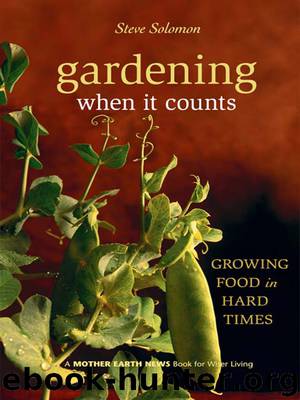Gardening When It Counts by Steve Solomon

Author:Steve Solomon
Language: eng
Format: epub
Tags: GAR025000
ISBN: 9781550923858
Publisher: New Society Publishers
Published: 2006-01-29T16:00:00+00:00
* Multiply by 2.54 for centimeters.
** Multiply by 7 to obtain kpa (kilopascals); multiply by 1.42 to obtain meters of head.
† Multiply by 3.785 for liters †† Multiply by 30.48 for centimeters
Figure 6.6
Sprinkler systems that apply less than half an inch (1.25 centimeters) per hour are best for the garden but do have drawbacks. Sun, wind, and high air temperatures can combine to break up fine streams of water and evaporate them nearly as fast as the sprinkler puts moisture out.Most criticism of sprinkler irrigation coming from drip enthusiasts (or drip equipment salespersons) is based on this misuse of the method. Small sprinkler heads are not useless, but you should not use them when the sun is strong and the wind is blowing. Sprinkling when it is calm and the sun is lower or hidden by clouds is more efficient, too, because little or no water is lost before it enters the earth.
It is possible to design a system with such a low application rate that you can water a clay soil all night long, from bedtime to breakfast, without risk of overwatering. At night there is rarely any wind, and for rural homesteaders with limited-output wells, this is also the time when there is no competition from showers, dishwashing, and so on.Watering at night is widely believed to be harmful to plants, but it may actually be the best time to water if your heavy soil allows you to do it all night without leaching. Plants are naturally dampened by dew for the last few hours of the night; during summer they quickly dry off in the morning.You can harm plants by watering them just before dark, stopping the irrigation, and leaving the plants damp all night. These are ideal conditions for the multiplication of disease organisms.Watering all night continuously washes bacteria and fungus spores off the plants before they can do any damage. This principle is well understood by nurseries that propagate healthy plants from root cuttings under a continuous mist.
On lighter soils, the best sprinkler design is one that spreads about a quarter of an inch (six millimeters) per hour, allowing you to apply a layer half an inch to three quarters of an inch (12 to 19 millimeters) thick when you sprinkle for a few hours in the early morning before breezes start up and the sun gets strong.
Although nozzles even smaller than the ones noted in Figure 6.6 are available, 1/16-inch (1.8-millimeter) bores are about the minimum effective size for veggie gardening. Systems designed around this nozzle size cover the largest amount of ground while using the smallest possible number of gallons per minute to do it. Bores with a smaller diameter can’t spray far enough to achieve even lower application rates, so you need to use many more sprinklers to cover the same area. This gets expensive.
As the bores in nozzles get larger than 7/64 inch (2.75 millimeters), they start emitting droplet sizes too massive for a veggie garden. These might be fine for
Download
This site does not store any files on its server. We only index and link to content provided by other sites. Please contact the content providers to delete copyright contents if any and email us, we'll remove relevant links or contents immediately.
Turbulence by E. J. Noyes(7981)
The Thirst by Nesbo Jo(6882)
Gerald's Game by Stephen King(4611)
Be in a Treehouse by Pete Nelson(3999)
Marijuana Grower's Handbook by Ed Rosenthal(3643)
The Sprouting Book by Ann Wigmore(3562)
The Red Files by Lee Winter(3392)
The Remains of the Day by Kazuo Ishiguro(3348)
Sharp Objects: A Novel by Gillian Flynn(2985)
Christian (The Protectors Book 1) by L. Ann Marie(2669)
Organic Mushroom Farming and Mycoremediation by Tradd Cotter(2661)
The Culinary Herbal by Susan Belsinger(2453)
Stone Building by Kevin Gardner(2374)
The Starter Garden Handbook by Alice Mary Alvrez(2310)
Lilac Girls by Martha Hall Kelly(2273)
The Unlikely Pilgrimage of Harold Fry by Rachel Joyce(2242)
The Lean Farm Guide to Growing Vegetables: More In-Depth Lean Techniques for Efficient Organic Production by Ben Hartman(2107)
Urban Farming by Thomas Fox(2083)
Backyard Woodland by Josh VanBrakle(1910)
